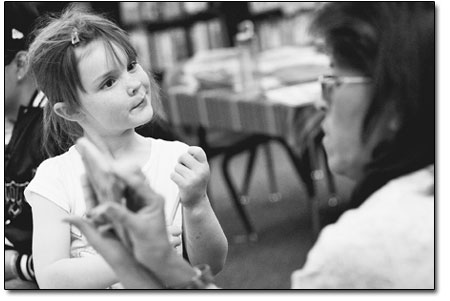| ||
Alma after school
by Amy Donahue Twelve elementary school kids sit around newspaper-covered tables in the Needham Elementary School library, giggling and sharing stories from their day at school. But this is not simply a social gathering. They are intently focused on creating “trees of life” on clay slabs, this week’s activity in the Alma After School program. Del Alma, the Durango Education Alliance for Multicultural Achievement, is a nonprofit group working to promote cultural competence and educational excellence for the area’s multicultural youth. The trees of life follow in the tradition of Mexican folkloric art, telling a story from roots to branches. Trees of life originally told the story of Adam and Eve, and are now typically seen in association with Mexico’s Day of the Dead celebrations, said Emily Olson, director of programs at Del Alma. However, these trees tell the story of three books the Alma After School kids have been reading over the past weeks. Some are adorned with dogs, baskets or poinsettias; another features a food fight. The children have picked pieces of the story that they deem important to telling the story visually on their trees. “We had a little mishap with the larger ones we made at the studio,” says Crystal Harris, the Coordinator. “They’re taking it pretty well though.” Reaching out to the community is a major goal of Alma After School. The current unit, focusing on the art of storytelling, was supplemented by field trips to local artist Mark Jaramillo’s studio beneath his downtown store, The World According to Mark. Two of these field trips yielded large trees of life, each telling a story as depicted by the students. However, cold weather and increased moisture in the last few weeks led to shattered projects in Jaramillo’s kiln, said Maya Pierce, a Fort Lewis College senior volunteering with the program. A previous unit with a music theme featured a Durango High School music teacher demonstrating how to play Native American gourd rattles. This week, a guest speaker will teach the kids how to play Native American string games. “We exist to promote cultural competency, which fosters a deep level of self esteem, respect among the students, and respect for different cultures, beliefs, religions and ethnicities,” said LeeAnn Vallejos, Del Alma director. Harris said she’s seeing these goals emerge even in the first year of the program. “To have a 5-year-old say ‘I am Mexican’ is huge,” she said. “We’re trying to dispel the myths and fears associated with cultural identity.” Alma After School is just one of many programs hosted by Del Alma. Del Alma, which was known until 2007 as the Durango Latino Education Coalition, was founded in 1995. After acting as a tutoring program for 12 years, Del Alma was restructured in January 2007 in order to address more systemic issues affecting academic achievement and low graduation rates. Instead of simply providing academic tutors, the group created after-school programs at the schools rather than off-campus locations, and also hired teachers at 9-R schools to collaborate. “The goal is for students to find our program enjoyable, fun and interesting, and then to associate those same feelings with school,” Vallejos said. “Lack of school bonding or connectedness has been identified on many levels as a predictor of low achievement.” To this end, the Alma After School program employs a curriculum that stresses study of the history, cultural contributions and current issues related to Latino, Hispanic and Native American populations in the southwest United States. The curriculum, composed of theme-based teaching units, is drawn from the Alma Project in Denver Public Schools. Units are based on scholarly information and are tied to state and district academic standards in an effort to promote academic achievement, Harris said. However, the focus is on projects and hands-on learning rather than bookwork. “The curriculum seeks to develop each student’s own understanding of themselves, strengthening their personal sense of self, and regard for their heritage and culture,” Vallejos said. Ranging from two to five weeks depending on content, units are chosen based on the time of year but not necessarily on specific holidays. “At Christmas, we had a market theme that looked at how markets occur worldwide,” Harris said. “We wanted to show the kids that it’s not like walking into Wal-Mart in other countries.” Currently, students are learning about storytelling. “This time of year, when it’s cold outside and snowing, storytelling is a big component of Native American culture,” Harris said. Alma After School currently enrolls around 20 students at each of the three elementary schools involved with the program: Needham, Riverview and Park. Harris said she hopes to see the program grow to include not only more students at schools already participating but to other schools throughout the district. “The schools have been really supportive, and we couldn’t have developed what we have without their help,” she said. “To expand the program, we’ll need even more support in the form of teacher liaisons.” Currently, Alma After School maintains a one-to-five teacher/student ratio. In order to maintain that ratio while expanding the program, Harris said gaining teacher support as well as more volunteers will be crucial. “Two and a half hours at each school is a good amount of time, but we’d like to do some extra activities on top of that,” she said. “Bigger field trips on Fridays when the schools have early release would allow the students from different schools to hang out and maybe we could go a little farther out of town.” •
|


